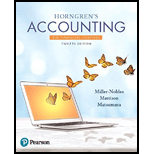
Cash Ratio: It is useful to evaluate the cash available as cash is an important factor for day to day operations for any business. It comes under liquidity ratios and cash is divided by current liabilities compute this ratio.
Times-interest-earned Ratio: It reflects company’s earnings as the times of its interest expenses. It is used to evaluate the ability to pay interest expense, a company has. Higher ratio is preferred as it enables to pay the obligation of interest.
Inventory Turnover: It is a part of efficiency ratios used during the process of ratio analysis. It reflects the number of times a company’s inventory is converted into sale during a particular period. The cost of goods sold is divided by average inventory to get the value of inventory turnover.
Gross Profit Percentage: This ratio evaluates the profitability of each dollar of sale. Gross profit is first step toward the profitability so companies are very keen to have a higher gross profit percentage. It enables them to cover the operating expenses related to business.
Debt to Equity Ratio: This ratio reflects the relationship of company’s total liabilities to total equity. It is used to represent financial leverage in the business. Higher ratio means that the company has used debts more than the owner’s capital to acquire the assets.
Earnings per Share of Common Stock: It is a mandatory term to be reported with the financials of a company in the annual report. It reflects the amount earned or lost on each outstanding common equity share. It is widely used to evaluate the performance of a business.
Price/Earnings Ratio: It depicts the relation of market price of a share to earnings per share of that company. The price/earnings ratio presents the market value of the amount invested to earn $1 by a company. It is major tool to be used by investors before the decisions related to investments in a company.
1.
a.
To Compute: The current ratio of G Company for 2017 and 2018.
b.
To Compute: The cash ratio of G Company for 2017 and 2018.
c.
To Compute: The times-interest-earned ratio of G Company for 2017 and 2018.
d.
To Compute: The inventory turnover of G Company for 2017 and 2018.
e.
To Compute: Gross profit percentage of G Company for 2017 and 2018.
f.
To Compute: The debt to equity ratio of company G for 2017 and 2018.
g.
To Compute: The rate of return on common stockholders’ equity of company G for 2017 and 2018.
h.
To Compute: The earnings per share of common stock of company G for 2017 and 2018.
i.
To Compute: The price/earnings ratio of company G for 2017 and 2018.
2.
a.
To Analyze: The change in company G’ ability to pay debts and to sell inventory during 2018.
b.
To Analyze: The change in investment attractiveness of company G’s common stock during 2018.
Want to see the full answer?
Check out a sample textbook solution
Chapter 17 Solutions
Horngren's Accounting, The Financial Chapters (12th Edition)
- The actual cost of direct labor per hour is $16.25 and the standard cost of direct labor per hour is $15.00. The direct labor hours allowed per finished unit is 0.60 hours. During the current period, 4,500 units of finished goods were produced using 2,900 direct labor hours. How much is the direct labor rate variance? A. $3,625 favorable B. $3,625 unfavorable C. $4,350 favorable D. $4,350 unfavorablearrow_forwardOn January 1 of the current year, Piper Company issues a 4-year, non-interest-bearing note with a face value of $8,000 and receives $4,952 in exchange. The recording of the issuance of the note includes a: a. credit to Notes Payable for $4,952. b. credit to Discount on Notes Payable for $3,048. c. debit to Discount on Notes Payable for $3,048. d. debit to Cash for $8,000.arrow_forwardPLease helparrow_forward
- What is the budgeted total cost of direct materials purchases?arrow_forwardHy expert provide answer with calculationarrow_forwardDuring September, the assembly department completed 10,500 units of a product that had a standard materials cost of 3.0 square feet per unit at $2.40 per square foot. The actual materials purchased consisted of 22,000 square feet at $2.60 per square foot, for a total cost of $57,200. The actual material used during this period was 25,500 square feet. Compute the materials price variance and materials usage variance.arrow_forward
- Bluesy Electronics recorded the following financial data: Net Sales $720,500 Average Inventory at Cost = $80,200 Gross Margin Percentage = 42% Calculate the GMROI.arrow_forwardNeed help this question solutionarrow_forwardXYZ Company has a gross profit margin of 0.30, an operating profit margin of 18%, a total asset turnover ratio of 2.0x, and cost of goods sold of $700,000. The company's tax rate is 35%, and it has no debt. Calculate XYZ Company's Return on Assets (ROA).arrow_forward

 AccountingAccountingISBN:9781337272094Author:WARREN, Carl S., Reeve, James M., Duchac, Jonathan E.Publisher:Cengage Learning,
AccountingAccountingISBN:9781337272094Author:WARREN, Carl S., Reeve, James M., Duchac, Jonathan E.Publisher:Cengage Learning, Accounting Information SystemsAccountingISBN:9781337619202Author:Hall, James A.Publisher:Cengage Learning,
Accounting Information SystemsAccountingISBN:9781337619202Author:Hall, James A.Publisher:Cengage Learning, Horngren's Cost Accounting: A Managerial Emphasis...AccountingISBN:9780134475585Author:Srikant M. Datar, Madhav V. RajanPublisher:PEARSON
Horngren's Cost Accounting: A Managerial Emphasis...AccountingISBN:9780134475585Author:Srikant M. Datar, Madhav V. RajanPublisher:PEARSON Intermediate AccountingAccountingISBN:9781259722660Author:J. David Spiceland, Mark W. Nelson, Wayne M ThomasPublisher:McGraw-Hill Education
Intermediate AccountingAccountingISBN:9781259722660Author:J. David Spiceland, Mark W. Nelson, Wayne M ThomasPublisher:McGraw-Hill Education Financial and Managerial AccountingAccountingISBN:9781259726705Author:John J Wild, Ken W. Shaw, Barbara Chiappetta Fundamental Accounting PrinciplesPublisher:McGraw-Hill Education
Financial and Managerial AccountingAccountingISBN:9781259726705Author:John J Wild, Ken W. Shaw, Barbara Chiappetta Fundamental Accounting PrinciplesPublisher:McGraw-Hill Education





